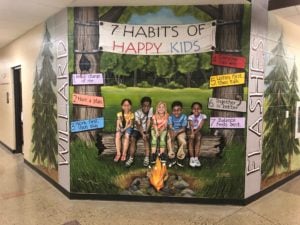Every politician and administrator in America is under increasing pressure to improve school safety and security. The result? An avalanche of well-intentioned seminars, dubious “security” products, questionable laws, and controversial policies. And still, there are scarce additional dollars available to support improvements in school safety.
Fortunately, some of the highest impact improvements you can make to school safety and security are low cost (even no-cost) and entirely uncontroversial.
In fact, one of the most cost-effective investments you can make in school safety will never ruffle feathers: Paint murals to reinforce school spirit.
Maintaining “School Climate” Improves School Safety
Michael Dorn is executive director of Safe Havens International, the world’s largest school safety center. Safe Havens has assisted with school safety and security assessments in close to 8,000 schools in eleven countries. Mr. Dorn has personally worked 16 active shooter school events and 300 other school crisis events. He is among the most experienced, widely published, and highly respected school safety experts in the world.
“As you ramp up your physical security,” Dorn explains, “adding cops in schools, metal detectors, buzzer access, any of the things that we would call ‘physical hard measures’—the more you do that, you need murals, artwork, and color schemes to maintain the school climate. In peer-evaluated solid research, ‘school climate’ has been the number one most effective way to prevent homicide in schools.”
“School climate” encompasses three key pillars of school safety:
- Relationships
- Supervision
- Territoriality
Each exists independently, but each reinforces the others. When properly leveraged, they form an interlocking tripod to give your school a rock-steady safety foundation.
Good Student-Staff Relationships Improve School Safety
Dig behind the headlines, and you find that a large number of potential school attacks—as well as countless other acts of violence and mischief—were foiled by students coming forward to inform administrators and authorities in advance. A 2011 report from the University of Chicago found that “even in high-poverty, high-crime neighborhoods, the quality of relationships among adults and students at a school can turn one school into a safe haven while another languishes as a center of violence.”
Maintaining a good school climate is key to opening active lines of communication. “If you turn the place into Sing-Sing,” Dorn points out, “the kids don’t come forward and tell you what you need to know to stop an attack before it happens.”
Smarter Student Supervision Makes Safer Schools
When students and staff have good working relationships, neither objects to closer supervision between educators and their students. “Supervision absolutely can reduce death in active shooter events,” Dorn remarks,”That’s been well proven.”
The benefits of improved student supervision aren’t limited to rare active shooter events. Closer—and smarter—supervision of students mitigates every risk and threat that schools face, including:
- non-custodial parental abduction
- non-custodial adult contact with children
- sexual assault
- accidental deaths
- drug abuse on campus
- violence between students
- bullying
- playground accidents
- extreme weather
- fires
“The leading cause of death that we have hard data for, is people being hit by cars and other vehicles in the school parking lots and drives,” Dorn points out. The National Center for Education Statistics reports a total of 334 school-associated homicides between 2002 to 2011, and fewer than 50 in active shooter events. During that same period, 1,351 people died at schools in vehicle-related incidents.
Design Enhances School Safety Using Territoriality
Territoriality is one of the three core concepts of CPTED (Crime Prevention Through Environmental Design). In any space, reinforcing territoriality enhances safety and security in two ways:
- It creates a sense of ownership among those who should be there. People are more likely to maintain and monitor places they “own”, preventing common hazards like falls. They will also protect the space from intruders and others who wish to do harm.
- It naturally makes intruders uncomfortable, making them easier to detect.
As an added benefit, Safe Havens notes that “territoriality also sets the tone for what is acceptable behavior.” This reduces the drain on student morale and staff resources that comes from constant disciplinary action.
What does it take to establish good, clear territoriality in your school? This is where school spirit and paint come into play. According to Safe Havens:
“Territoriality [in schools] is commonly achieved through measures that tie legitimate building occupants to the school through murals, artwork, color schemes, and a variety of building design features. Many schools with intensive security approaches feel welcome and warm because of significant efforts to treat people politely, combined with excellent territoriality. In school safety, sometimes the culture of how things are done can be as important as what is done to make people safer. Positive territoriality combined with respectful staff interaction can help to prevent what would otherwise seem to be a prison-like environment.”
More Low-cost/No-Cost School Safety Measures
Safe Haven made this free ebook covering the 20 most practical low-cost/no-cost safety improvements schools can make. The book focuses on evidence-based practices drawn on Safe Havens’ thousands of school safety/security assessments and interviews. Measures range from simple changes in procedure and training (such as outlining a good “shelter in place” protocol—a widely misunderstood procedure) to more fundamental shifts in how we think about and plan for school emergencies.
As a first step, Micheal Dorn firmly believes it’s vital for every school to ask: “are we doing some sort of formal, multi-disciplinary assessment on a regular basis?” These can be cheap or free; there are many resources available to aid schools in emergency planning.
But you don’t need to make this a 100% do-it-yourself venture. In most areas, local law enforcement, fire service, emergency management, and Department of Homeland Security personnel are eager to work with schools on such assessments.
“We really do want to see people use reliable assessments. In some states, these are free or there is assistance available to get an assessment done. You don’t necessarily have to hire someone to get a really good assessment.”



